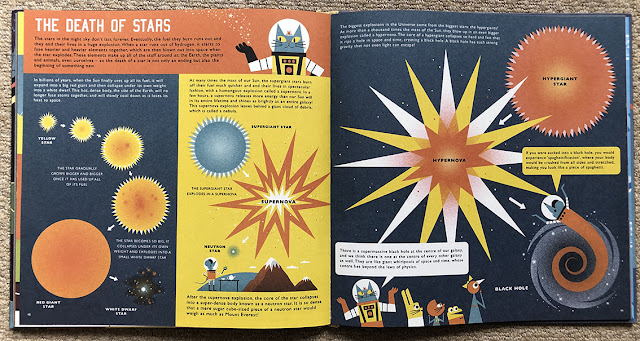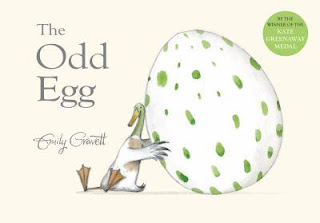My new book The Greatest Show is coming out imminently. It’s the story of life on Earth, performed by insects in a shoebox theatre. It’s described as ‘Non-Fiction’. But is it?
In this post I want to tell you a bit about my experience of wrestling with deep geological time and the paleontological past of Earth, show you my favourite research books, and look at a few non-fiction picture books and how they use the page visually… and maybe have a peek at the boundaries of non-fiction – where’s the line where it becomes fiction?
Researching the Greatest Show….
 |
| This is a Very Useful Chart for keeping track of your geological eras of the Earth |
I don't have a proper science background, and I found when I was trying to research periods of time for the Greatest Show that what was
tricky was that information didn't stick, so when I came to each page to build the pictures, I had to research it all anew. My double page spreads were roughly 50 cm wide - which worked well for
quite a lot of geological periods – there was often about 50 million years
between whatever event (usually some sort of mass extinction) marked a new time
zone. My Tape Measure of Time – could unfurl at a scale of 1cm to 1 million
years.
But 50 million years is a REALLY long time, and I had to make my slice of tape measure just tell one or two main stories about the climate, so I needed to know enough about everything that happened to be able to decide what was important.
 |
| In this slice of Tape Measure, Annette and Anton are showing how oxygen levels rose in the Carboniferous era. |
 |
| This is where there's the WORST MASS EXTINCTION of ALL TIME, at the Permian-Triassic boundary. |
 |
| This is that quite recent mass extinction when Alan the Asteroid extinctified the dinosaurs (and lots of other animals.) |
But whenever I got bogged down or mind-boggled about how to boil down Earth’s massively intense and complicated story, I had three go-to children’s information books. So here are my three Earth-Story bibles:
Book One: Dinosaurs: A Children's Encyclopedia
 |
| Pub. 2011, consultant Darren Naish. It's about so much more than dinosaurs, just about every other life form is in there as well. |
 |
| I'm always captivated by this glimpse of Ediacaran sea and swaying Charnias, it's like going in a time machine for a visit. |
 |
| Here's a Precambrian animal, Opabinia, with its random five eyes, reaching out of the page to shake you by the hand. |
Book Two: Hannah Bonner's Prehistoric Trilogy (OK I’m cheating, this is obviously three books.)
 |
| When Bugs Were Big, When Fish Got Feet, and When Dinos Dawned, all by Hannah Bonner. |
Book Three: The What on Earth? Wallbook of Natural History
 |
| by Christopher Lloyd and Andy Forshaw. You can see it's so well used that it has collapsed. |
Non-fiction is a picture book challenge – to make and also to read. Reading non-fiction can be a difficult for those who like a well-aerated page, who get distracted and confused if there’s too much to see on the page (like me). So it's a visual challenge to design non-fiction pages that say what they need to, but in a digestible way, and I think the non-fiction illustrator has to use every element at their disposal to distill the message they want to tell.
Just grabbing a few favourite non-fictions from my bookshelves, I have picked out Animalium, Professor Astro Cat and On the Origin of Species.
From my bookshelves: Animalium
 |
| by Katie Scott and Jenny Bloom |
 |
| It's on a generous scale, like the Birds of Audobon. There's lots of space for the exhibits, who are large. The displays show what's inside animals and also terrariums of creatures assembled. |
From my bookshelves: Professor Astro Cat's Frontiers of Space
 |
| by Dr Dominic Walliman and Ben Newman |
 |
| The designs and illustrations of Ben Newman use shape and proportions and retro colour palettes to bring a lot of physics to the reader. |
 |
| Find a solar system in your fruit bowl. |
From my bookshelves: On the Origin of Species
 |
| by Sabina Radeva |
Non-Fiction or not Non-Fiction?
With the Greatest Show, the challenge was
to bring Life on Earth to readers as a story. I wanted the
reader to see at a glance THE MAIN STORY, to know where to look first. But then
to be able to delve deeper in, if they wanted to. So I took the model of the theatre stage - where your main stage is your first focus, and then you can peruse the wings and also see what's going on down at the Tape Measure of Time.
 |
| The Shoebox Theatre Plan - so you know where to look first to see in a snapshot what's going on. |
But NOTHING in this book is at all realistic or like it really would have been. I mean - do insects do puppetry? Can they read? Would a cockroach be able to operate a spoon? Even my troupe of insects – well, they haven’t got mandibles and compound eyes – but then it’s hard to feel empathy for the true face of an insect.
 |
| The True Face of an Insect (this one's a beetle.) |
 |
| My troupe of critters |
So does Greatest Show rather stretch the definition of 'non-fiction'? Books get organised exclusively into 'fiction' and 'non-fiction', but is there a cross-over zone? The gap between fiction and non-fiction – is there one? Is there an overlap?
 |
| I highly recommend Henry Gee's vivid and entertaining romp through 4.6 billion years. |
Henry Gee’s book, A (Very) Short History of Life on Earth, tells it like a story. It starts: "Once upon a time, a giant star was dying." - and there we are, at the very beginning of the dawn of Earth, and its "Song of Fire and Ice". The story has acted like a time-portal, to transport us to witness the dear old Earth's very beginnings, and that's the magical thing that stories can do.
The World of Story
With my book I wanted to find out if there was a way of making the evolution of life on Earth over 4½ billion years into a story to give young readers a first scaffold to start hanging their knowledge of life on Earth upon. Why a story?
Because maybe humans are uniquely good at absorbing information through stories. Think of remembering with Memory Palaces, navigating with songlines. Before writing, story was how information was passed down generations. Stories are memorable. Story makes us want to know what happens, makes us pay attention.
But story is also a miracle. How is it possible that I can tell you a story of insects putting on a performance, and you’re prepared to go along with this crazy idea? It’s because of the power of story to seize our imaginations and curiosity. But we have to watch out – The Story’s power is really strong, and as we can see unfolding in the world today, its power can be used for good or for ill.
The Greatest Show on Earth is coming to shops on 28th April.
Another of Mini's book-involvements is The Book of Not Entirely Useful Advice, with AF Harrold. Her BlogSite is at Sketching Weakly.































